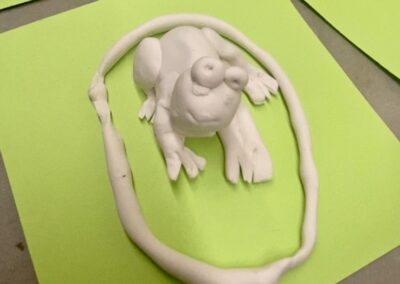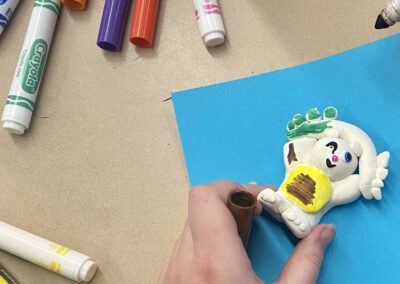Playful 3D Rainforest Animals
Developed by Alexandria McKay, PCM Playful Practicum 2022
(FOCUS: Grade 5, Elementary Art)
Let’s be artists and scientists as we research and explore rainforest animals!
Interdisciplinary Art Lesson with a Connection to ELA Rainforest Unit in Grade 5
Children will discover animals of the rainforest through playful construction using 3 dimensional materials. This lesson connects directly to the Grade 5 ELA curriculum, in which students will research biodiversity in the rainforest and respond to their learning through writing prompts. However, the ELA connection does not need to be incorporated to complete this lesson. Children could instead research and choose a rainforest animal as the inspiration for their 3D animal form.
To complete this lesson children will be provided with 3D materials such as Crayola Model Magic, Air Dry Clay, clay, or recycled materials to experiment with. Children are encouraged to play with the materials to discover processes, methods and techniques to work with the materials and construct a rainforest animal form. Children can also use scissors and markers as tools for creation and construction.
Materials
- Crayola Model Magic- OR any 3D materials are available to you:
- Clay or Air-Dry Clay
- Recycled Materials: Cardboard tubes, pipe cleaners, newspaper, etc.
- Scissors
- Washable markers
Set Up
If using model magic or any kind of clay, divide it into even pieces prior to use so each child will receive the same amount of clay.
If using 3D recycled materials, prep the materials in advance so they are easily accessible.
If in a classroom setting, one option is to place an assortment of materials in the center of table groups, or you could set them up in a space in the classroom, such as a table, where students can easily access the materials.
Another option is to provide children with a list and have them bring in recycled materials from home. Children could use their own materials that they brought in to create their animals.
Student’s Job
- Can you construct a 3D model of an animal found in the rainforest using the materials available to you?
- How can you show what the animal looks like based on your learning (in ELA)?
- How will you show the details, features, and characteristics that are important to your animal?
Further Challenges:
Write an artist statement describing the process of creating your rainforest animal form. What challenges did you face? What was successful?
Teacher’s Job
Standards Alignment
VA: Cr1.2.5a: Identify and demonstrate diverse methods of artistic investigation to choose an approach for beginning a work of art.
VA: Cr2.1.5a Experiment and develop skills in multiple art-making techniques and approaches through practice.
Common Core State Standards ELA
CCSS.ELA-LITERACY.W.5.3 Write narratives to develop real or imagined experiences or events using effective technique, descriptive details, and clear event sequences.
CCSS.ELA-LITERACY.W.5.4Produce clear and coherent writing in which the development and organization are appropriate to task, purpose, and audience. (Grade-specific expectations for writing types are defined in standards 1-3 above.)
CCSS.ELA-LITERACY.W.5.6With some guidance and support from adults, use technology, including the Internet, to produce and publish writing as well as to interact and collaborate with others; demonstrate sufficient command of keyboarding skills to type a minimum of two pages in a single sitting.
Connections to previous work?
During their EL skills block, students read to build knowledge about the rainforest and analyze narrative writing to build proficiency in writing first person narratives about the rainforest. Students build background knowledge on biodiversity in the rainforest and rainforest deforestation to understand why scientists, like Meg Lowman, study the rainforest. Students closely read excerpts of The Most Beautiful Roof in the World by Kathryn Lasky and other texts to identify text structure and practice summarizing the text.
This Unit centers on CCSS ELA W.5.3, W.5.4, and W.5.6. (Researching to Build Knowledge and Teach Others: Biodiversity in the Rainforest | EL Education Curriculum, n.d.)
Prepare/ Background Info
The Most Beautiful Roof in the World by Kathryn Lasky
The Great Kapok Tree by Lynne Cherry
Facilitation Strategies
Utilize the “Hands-in-Pocket” technique to effectively encourage children to solve challenges independently.
When children ask for help, ask questions to guide children to find a solution without demonstration from the teacher.
Play to Notice
Child Centered
Choice
Challenge
Active
Make Learning Visible
Content Matter to Notice
The Elements of Art: Form is an object that is 3-Dimensional, and/or has length, width, and height. An artform can be geometric or organic in shape.
Grade 5 EL Education Curriculum: Researching to Build Knowledge and Teach Others: Biodiversity in the Rainforest
SEL to Notice
- “Central to EL Education’s curriculum is a focus on “habits of character” and social-emotional learning. Students work to become effective learners, developing mindsets and skills for success in college, career, and life (e.g., initiative, responsibility, perseverance, collaboration); work to become ethical people, treating others well and standing up for what is right (e.g., empathy, integrity, respect, compassion); and work to contribute to a better world, putting their learning to use to improve communities (e.g., citizenship, service).
- In this module, students work to contribute to a better world: put their learning to use to improve communities (e.g., citizenship, service).
- Students also focus on working to become effective learners, developing the mindsets and skills for success in college, career, and life (e.g., initiative, responsibility, perseverance, collaboration).” (Researching to Build Knowledge and Teach Others: Biodiversity in the Rainforest | EL Education Curriculum, n.d.)



0 Comments